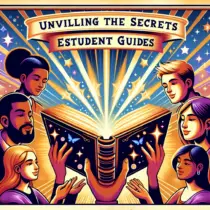Student guides play a crucial role in providing essential information and support to students throughout their academic journey. These guides act as a compass, helping students navigate through the complex world of education. They provide valuable insights and tips on various aspects of student life, including academics, extracurricular activities, and personal development. However, not all student guides are created equal. Some are more effective than others in fulfilling their purpose. In this article, we will unveil the secrets of effective student guides and explore how they can make a significant difference in the lives of students.
Effective student guides are those that go beyond the basic information and truly understand the needs and challenges students face. They provide practical advice and strategies to help students overcome obstacles and achieve success. These guides are well-organized, comprehensive, and user-friendly, making it easy for students to find the information they need quickly and efficiently.
Providing Comprehensive Information
One key element of an effective student guide is providing comprehensive information on a wide range of topics related to student life. This includes academic resources such as course schedules, study tips, and academic support services. It also includes information on extracurricular activities like clubs and organizations, sports teams, and volunteering opportunities.
An effective student guide should also cover essential topics like campus safety measures, health services, financial aid options, career development resources, and counseling services available to students. By covering these areas comprehensively, a student guide ensures that students have access to all the necessary resources to thrive academically and personally.
Engaging Content
An effective student guide should have engaging content that captures the attention of readers and keeps them interested throughout. The use of clear language that is easy to understand is crucial for ensuring that even younger readers can benefit from the guide. The content should be concise and to the point, avoiding unnecessary jargon or complex terminology.
Furthermore, an effective student guide should incorporate relevant examples, anecdotes, and real-life stories to make the content relatable and practical. This not only helps students understand the information better but also makes it more memorable and enjoyable to read. Visual aids such as infographics, diagrams, and images can also enhance engagement and make complex concepts easier to understand.
Additionally, providing links to an easy free image editor can empower students to create their visual aids and enhance their understanding of complex concepts.
Accessible Format
Another secret of effective student guides lies in their accessibility. A well-organized guide with clear headings and subheadings makes it easy for students to navigate through the content and find what they are looking for quickly. The use of bullet points, lists, and tables can further enhance readability.
In today’s digital age, it is important for student guides to be available in various formats such as PDFs, e-books, or online platforms. This allows students to access the guide from anywhere at any time using their preferred devices. Additionally, a searchable index or table of contents can help students locate specific information within the guide efficiently.
Regular Updates
An effective student guide should not remain static but undergo regular updates based on new developments or changes in policies and procedures. Keeping the guide up-to-date ensures that students have accurate information at all times. This includes updating contact details for key faculty members or support services so that students can easily reach out for assistance when needed.
Regular updates also provide an opportunity to incorporate feedback from students and address any gaps or areas of improvement identified by them. This iterative process ensures that the student guide remains relevant and continues to meet the evolving needs of students over time.
Frequently Asked Questions (FAQ)
Q: Can student guides be beneficial for college students?
A: Yes, student guides are not limited to a specific educational level. They can be equally beneficial for college students as they provide valuable information and resources that can assist them in navigating through their college experience.
Q: Are student guides only useful for academic purposes?
A: No, student guides cover various aspects of student life beyond academics. They also provide information on extracurricular activities, campus services, health and wellness resources, career development opportunities, and much more.
Q: How often should student guides be updated?
A: Student guides should undergo regular updates to ensure accuracy and relevance. It is recommended to review and update the guide at least once a year or whenever significant changes occur in policies or procedures.
Q: What are the benefits of incorporating real-life examples in a student guide?
A: Incorporating real-life examples in a student guide makes the content relatable and practical. It helps students understand the information better and makes it more memorable. Real-life examples also demonstrate how the strategies or tips provided in the guide can be applied in real-world situations.
Q: Can student guides help improve academic performance?
A: Yes, effective student guides provide valuable study tips, time management strategies, and academic support resources that can help improve academic performance. By following the advice provided in the guide, students can enhance their learning experience and achieve better results.
In conclusion, effective student guides play a vital role in supporting students throughout their educational journey. By providing comprehensive information, engaging content, accessible formats, and regular updates, these guides empower students to make informed decisions and succeed academically and personally. Whether it’s finding the right resources or understanding campus services, an effective student guide can make all the difference in a student’s life.









